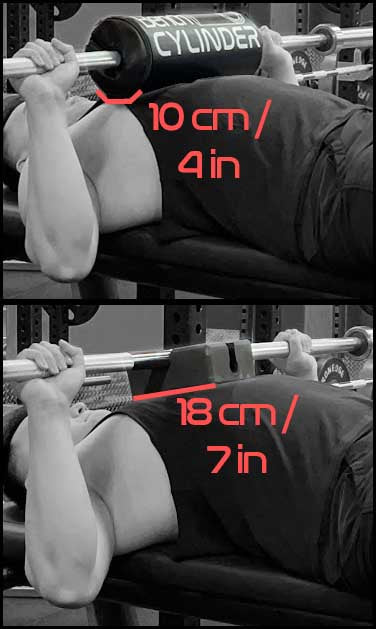
The Science Behind Bench Cylinder
The Bench Cylinder revolutionizes Partial ROM Training by maintaining optimal tension in the chest and triceps throughout each lift.
Unlike the flat surfaces of Bench Blocks and Board Presses, which distribute weight broadly across the chest, the Bench Cylinder's cylindrical shape concentrates stress directly onto the muscles under the barbell. This focused pressure enhances muscle activation, maximizing strength and muscle gains.
Imagine the difference between someone standing on you in sneakers (Board Press and Bench Blocks) versus high heels (Bench Cylinder). The Bench Cylinder's rounded surface reduces the contact area, shifting stress precisely onto the chest and triceps—exactly where it's needed for optimal muscle development.
Bench Cylinder offers several advantages over the flat nature of the board press:
Contact Area: Bench Press boards provide a flat surface across the chest, distributing the weight of the barbell more uniformly over a larger area compared to the cylindrical shape of the Bench Cylinder. The Bench Cylinder offers a smaller contact area with the chest. This results in a more concentrated stress on the muscles directly under the barbell, enhancing muscle activation in the targeted areas (chest and triceps).
Reduced Stress on Joints: The flat nature of the board press distribute weight more broadly across the body, increasing stress on the joints, especially in the shoulders. In contrast, the rounded shape of the Bench Cylinder reduces such stress by promoting a more natural alignment during the lift.
Improved Stability: The cylindrical shape of the Bench Cylinder promotes stability during bench press exercises. It requires you to maintain balance and control throughout the lift, which is crucial for lifting heavier weights safely and effectively.
Enhanced Muscle Engagement: The round shape of the Bench Cylinder encourages more natural muscle activation during bench press exercises. It allows for a more consistent engagement of the chest and triceps throughout the lift, optimizing muscle recruitment and strength gains. By concentrating stress onto the chest and triceps rather than spreading it across the body, the Bench Cylinder promotes more focused muscle engagement. This will lead to more effective muscle development and strength gains over time.

Similarly, in a Pin Press, the pins "catch" the weight which causes the weight of the barbell to be completely dispersed into the pins/safeties. This causes all of your muscles to completely relax. When muscles relax completely against the pins, they lose tension and are not in an optimal state for generating force. Attempting to initiate a lift from this relaxed state can strain muscles, particularly when dealing with heavy loads. This abrupt transition can lead to muscle pulls, strains, or even tears, especially in muscles unprepared for sudden force application.
Additionally, the sudden application of force to the joints during a Pin Press, especially after relaxation against the pins, can stress joints beyond their normal capacity. This can lead to joint injuries or exacerbate existing joint issues.
In other words, there is nothing else out there that can increase your Bench Press like the Bench Cylinder.
Bench Cylinder Is The Best Way To Do Partial ROM Training
-
Pin Press
❌Low Muscle Activation
❌Low Strength Gains
❌High Risk of Injury
-
Bench Block/Board Press
❌Moderate Muscle Activation
❌Moderate Strength Gains
❌Moderate Risk of Injury
✅High-Density EVA Foam
❌No Water-Resistant PU Leather
-
Bench Cylinder
✅High Muscle Activation
✅High Strength Gains
✅Low Risk of Injury
✅High-Density EVA Foam
✅Extra Layer of Safety
✅Water-Resistant PU Leather
✅Superior for Raw Lifters
